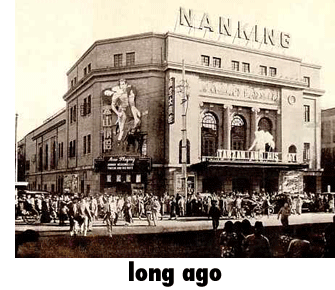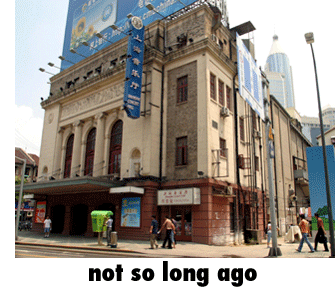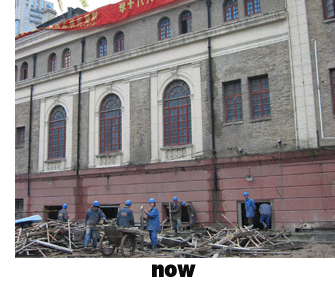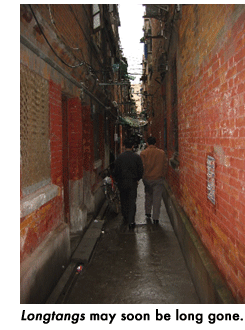Build Me Up, Tear Me Down
NOTE: A version of this piece was the cover story for the April 2003 issue of that’s Shanghai magazine. The South China Morning Post (subscription only) also ran a version.
by DAN WASHBURN
The Shanghai Concert Hall looks lonely. It sits by itself, surrounded by bulldozers and dirt, cowering in the shadow of Yan’an Elevated Highway. Once grand, the 73-year-old theatre now just looks grimy. This building deserves better. And later this month, many believe that’s just what it will get. The hall — all 5,650 tons of it — is being hoisted up and moved 70 meters southeast. It is the largest relocation project Shanghai has ever seen, and no doubt will be touted as a sign of the city’s dedication to preserving its past.
 Built during Shanghai’s early-1900s construction boom — which many compare to the city’s current race for world skyline supremacy — the former Nanking Theatre was Shanghai’s first venue for foreign films and was one of the few buildings of its era designed by a Chinese architect. Known for its excellent acoustics, the theatre has been used as a venue for symphony orchestras since 1959. After its relocation and renovation, the old concert hall will again welcome orchestras. Trees will be planted where the building once stood, and the Shanghai Concert Hall will become the centrepiece of the city’s Yan’an Dong Lu green-space.
Built during Shanghai’s early-1900s construction boom — which many compare to the city’s current race for world skyline supremacy — the former Nanking Theatre was Shanghai’s first venue for foreign films and was one of the few buildings of its era designed by a Chinese architect. Known for its excellent acoustics, the theatre has been used as a venue for symphony orchestras since 1959. After its relocation and renovation, the old concert hall will again welcome orchestras. Trees will be planted where the building once stood, and the Shanghai Concert Hall will become the centrepiece of the city’s Yan’an Dong Lu green-space.
The project’s price tag has been estimated at a hefty 50 million yuan. Meanwhile, entire neighbourhoods of old buildings are being destroyed on a daily basis. According to Shanghai government sources, more than 20 million square meters of old buildings have been demolished over the past 15 years with more than 3,000 high-rises going up in their place. The transformation shows no signs of slowing down, either. In February, construction began on the 101-story Shanghai World Financial Centre, a 492-meter mega-skyscraper expected to become the world’s tallest building when it is completed in 2007. A short walk from the Jin Mao Tower, currently the world’s third tallest building, it is the latest addition to the sci-fi movie set that is the Pudong skyline, China’s loud way of communicating its progress to the rest of the world.
 Shanghai’s raze and raise reconstruction policy has the city’s fledgling historic preservation community flustered. While activists don’t want to criticize the costly Shanghai Concert Hall plan — they are happy that the building is going to survive — they also don’t want one act of preservation to draw attention away from what they see as the systematic destruction of some of the best examples of early-20th century architecture in the world.
Shanghai’s raze and raise reconstruction policy has the city’s fledgling historic preservation community flustered. While activists don’t want to criticize the costly Shanghai Concert Hall plan — they are happy that the building is going to survive — they also don’t want one act of preservation to draw attention away from what they see as the systematic destruction of some of the best examples of early-20th century architecture in the world.
“The reason (the Shanghai Concert Hall) can be moved is because everything around it, the old neighbourhood around it, was torn down,” explains Patrick Cranley, an American who co-founded the Shanghai Historic House Association in 1998. “It would be nice to see money like that going to preservation as apposed to transportation. Everybody knows the Bund, but it’s the many buildings that perhaps are not on the tourist list that should be preserved.”
The clock is ticking, and Cranley knows it. According to his statistics, half of Shanghai’s old neighbourhoods have already been destroyed and another 20-25 percent are to be levelled this year. It’s all making way for the “better city, better life” Shanghai officials plan to introduce to the world when it arrives seven years from now for Expo 2010. “Shanghai has always been about being modern,” Cranley said. “So it should come as no surprise that there are a lot of cutting-edge designs going up in Shanghai. The second half of the 20th century can be seen as an anomaly in Shanghai’s history. There’s a big game of catch-up going on right now.”
 And at least one Shanghai government official believes the city has gotten ahead of itself. Zheng Shiling, a celebrated architect who heads the Shanghai Urban Planning Commission’s urban space and environment committee, recently said in an interview with Canada’s globeandmail.com that Shanghai’s skyline “is in confusion.” “There are too many tall buildings,” he continued. “Profit-chasing by developers has destroyed the urban space. The competition for higher and higher buildings has created a dinosaur city, with more and more gigantic buildings, and it’s not on a human scale. It’s not good for the life of the ordinary people.”
And at least one Shanghai government official believes the city has gotten ahead of itself. Zheng Shiling, a celebrated architect who heads the Shanghai Urban Planning Commission’s urban space and environment committee, recently said in an interview with Canada’s globeandmail.com that Shanghai’s skyline “is in confusion.” “There are too many tall buildings,” he continued. “Profit-chasing by developers has destroyed the urban space. The competition for higher and higher buildings has created a dinosaur city, with more and more gigantic buildings, and it’s not on a human scale. It’s not good for the life of the ordinary people.”
Zheng, who was comparatively closemouthed when interviewed by that’s Shanghai, submitted a proposal in late February that requested a slowdown of the large-scale construction in central Shanghai, the annual budget for which is 200 billion yuan. “The proposal has just been given to the mayor two weeks ago,” Zheng said in mid March, “so I do not know the result. I think it needs some procedure — a high-speed train cannot be stopped immediately.”
Some question whether a high-speed train can be stopped at all. Paul Lee, director of the School of Art at the University of Tennessee, used a grant from the National Endowment for the Humanities to study Shanghai architecture back in the mid-1990s. The basic premise of his project: the only way to preserve Shanghai’s historic architecture is with a camera. So Lee spent his time taking pictures of the buildings that helped Shanghai earn the nickname “museum of architecture” in the first half of the 20th century. Since then, Lee has studied Shanghai architecture closely — and sees his theory proven true all too often.
“I don’t think there is anything you can do,” the Hong Kong native said. “It’s a wholesale demolishing and urban renewal in a scale that we have never seen before. This process happens everywhere in Asia, especially in post-colonial cities. In some ways, the Chinese feel these weren’t our buildings to start with, so it’s OK to destroy them. It’s a sense of ownership. Now they feel like it’s their time to do the city the way they want to. It’s unsettling from the point of view of historical preservation because people don’t even have he slightest idea what it’s supposed to mean.”
 And that leaves Cranley’s in quite a conundrum. He’s a community activist in a country that has no history of community activism, in a city with a general populous that could care less about his cause. For example, the Shanghai Historic House Association is worried about the widespread destruction of li long or longtang neighbourhoods, compact communities with maze-like corridors and architecture with both Eastern and Western influences. But even the inhabitants of these longtangs — perhaps especially the inhabitants — aren’t really sorry to see them go. They are concerned more with practical matters, not preservation.
And that leaves Cranley’s in quite a conundrum. He’s a community activist in a country that has no history of community activism, in a city with a general populous that could care less about his cause. For example, the Shanghai Historic House Association is worried about the widespread destruction of li long or longtang neighbourhoods, compact communities with maze-like corridors and architecture with both Eastern and Western influences. But even the inhabitants of these longtangs — perhaps especially the inhabitants — aren’t really sorry to see them go. They are concerned more with practical matters, not preservation.
The longtangs just south of Xintiandi — which, as Cranley is quick to point out, is not so much a preserved longtang as it is a recreation of one — are slated for destruction. All the neighbourhood’s residents, even the ones who have lived there their entire lives, will be relocated to newer accommodations on the outskirts of the city. “Of course the high-rises will be more comfortable,” said one resident who gave the name Mr. Wu. “They have all the facilities that we need. The old buildings are not as convenient. We don’t have flush toilets. We don’t have enough room. Life here is extremely substandard. But shopping here is quite convenient. That’s one big reason why we like this part of the city.” Wu paused and added, “Those who are rich would probably prefer a renovated neighbourhood. Poor people like us would have no choice.”
Set aside for historic preservation in Shanghai’s 1999-2020 master plan are 398 buildings and 11 zones (approximately 1,385 hectares). Zheng and Cranley would like to see those figures more than double. But, Cranley said, numbers mean nothing if there are not laws and regulations to back them up. For example, unlike other countries, China has few financial incentives for owners of historic buildings. Nor is it clear in Shanghai code what can and cannot be done to buildings determined “historic.” Basically, Cranley said, the rules only say you can’t tear them down.
All of these grey areas can make it difficult for preservation-minded foreign architects to do business in Shanghai the way they would elsewhere. Often, the land has already been cleared before they even sign on. “To be honest, I’m very ambivalent about it,” said Chris Choa, partner and managing director of HLW, the New York-based architectural firm which last year won the rights to design Shanghai’s US$1.4 billion North Bund reconstruction project — which, he assures, will focus more on open spaces than skyline. “I don’t have recourse. I don’t have any legal ground. I can’t rely on landmark law like there is in the States or in Europe. There are times when it is so obviously an example of a bad thing to do that it doesn’t matter how good the fee is, we just don’t want to be associated with it. This may not stop the project from happening, but hopefully it will give developers pause.”
Cranley, for one, would like to pause as many developers as possible. But, he admits, his group has very little political pull — and a “pittance” of a budget.
“I think Shanghai’s renaissance is wonderful and that many of the buildings that are going up are magnificent,” he said. “Unfortunately, there are also plenty that are extremely pedestrian. The real issue is that real estate developers are making their plans without much thought given to the value of the historic stuff that their projects may displace. It’s a dollars and cents game and those who care more for dollars than sense are not contributing to the renaissance of Shanghai in a material way.”
To subscribe to the Shanghai Historic House Association’s newsletter, send a blank e-mail to shha-subscribe@topica.com. For information on how to join the SHHA, e-mail Patrick Cranley at wpc@asiamedia.net.
on the move
One hundred and thirty workers and 59 hydraulic jacks will lift the concert hall 1.5 metres above its original foundation early this month, according to Zheng Hua Qi, project manager for the Shanghai Liansheng Construction Company. A network of concrete girders, 1,800-tons and 55 centimetres thick, has already been cast beneath the 1,254-square-metre structure. Once lifted, the entire building — concrete “tray,” hydraulic jacks and all — will be pushed along sliding rails to its new location 66.4 metres away, a task that requires even more hydraulic equipment and some 11,800 tons of force.
“Projects of this magnitude are not common,” Zheng said. “Happens once in a couple of years, I guess. There are several contractors who do such projects in China, but projects as big as this are rare.”
The entire relocation is expected to last at least two months — it takes approximately 10 days alone for the concert hall to creep to its new address. When it arrives, it will be lifted another 1.8 metres and perched atop a brand new basement. After renovations and an expansion project that will widen the lobby and green room, the Shanghai Concert Hall, which hasn’t housed a concert since late last year, is expected to once again open its doors to the public in early 2004.
“It’s a classic theatre,” said Tess Johnston, who co-founded the Shanghai Historical House Association with fellow American Patrick Cranley in 1998. “The idea of … sliding it two blocks absolutely blows my mind. I mean I just can’t imagine that you can do that with a theatre. I can’t wait to see them do it. I’m thrilled to death. So much gets destroyed here that when they even save one thing I’m just blubbering with gratitude. It’s a lovely old building.”
Built in 1930 on an old cemetery plot, the Shanghai Concert Hall was designed by Chinese architects Zhao Shen and Fan Wenzhao in a time when plans for most of Shanghai’s new buildings were drawn up by Westerners. In typical neo-classical style, the theatre features ionic columns, arched windows and an elaborately decorated lobby with a grand dual staircase made of marble.
“It’s really quite spiffy,” said Johnston, author of “A Last Look: Western Architecture in Old Shanghai.” “It was from the old days when they did it right. I’ve never had a bad seat in the Nanking Theatre, and I’ve had them all, from the best seats to the cheapies.”
On March 25, 1930, the theatre celebrated its grand opening with a showing of the 1929 Hollywood production “Broadway.” It continued to be a popular venue for Western films throughout the 1930s and 40s. In 1950, it was renamed the Beijing Cinema and nine years later it was remodelled into a music house and given its current name. It was the venue of choice for the Shanghai Symphony Orchestra for much of the latter half of the 20th century and also attracted some of the world’s top musicians, including cellist Yo Yo Ma, violinist Isaac Stern and pianist Alicia de Larrocha.
“It has fantastic acoustics,” said 78-year-old violinist Wen Tan, who estimates he played more than 2,400 shows in the Shanghai Concert Hall as a member of the Shanghai Symphony Orchestra from 1953-1984. “The sound is much better than what we have in the Grand Theatre (which opened in 1998). It’s an old building and we don’t have such good acoustics in the modern ones.”
In recent years, however, symphonies weren’t the only sounds you could hear when seated in one of the concert hall’s 1,122 seats. Concerts would often come with an unwanted accompaniment: cars. Yan’an Dong Lu, known as Avenue Edward VII during the days of the Nanking Theatre, has become one of the Shanghai’s busiest thoroughfares.
“It used to be very noisy and there were many disturbances during performances,” Wen said. “It was bad.”
A plan to widen the street and construct an elevated train route through the area meant something had to be done with the Shanghai Concert Hall. Many assumed it would go the way of the cemetery that came before it. But Wen, for one, had a feeling the venerable theatre would live on.
“In New York, they kept Carnegie Hall,” he said. “So we have no reason to destroy this one.”

1 Comments
I was in Shanghai last summer, and I was incredibly pleased to find that vast stretches of the former International Settlement and French Quarter are still intact. Indeed, many of the villas and houses are now offices or pubs and bars. I just hope that the Chinese authorities come to realize that as more and more tourists travel to Shanghai from Europe as China becomes a more affordable destination they will realize that many westerners are interested in the history of Shanghai, and no matter how appealing Pudong may be of the ‘new China’ they will be missing a fantastic tourist opportunity should they bulldoze the buildings and environments of the Edwardian and 1920s periods. The Bund is all very well, but look at what lies behind it! An architectural goldmine, and a good earner for the Shanghai economy. We don’t want every city in Asia to look like America!